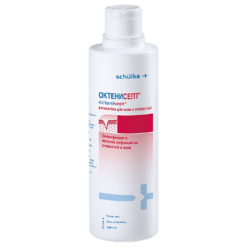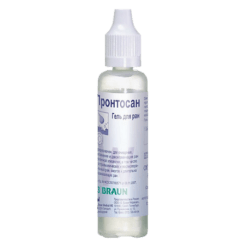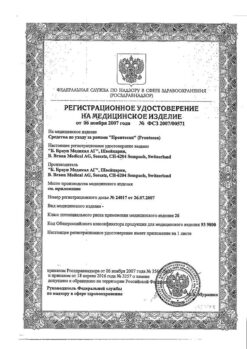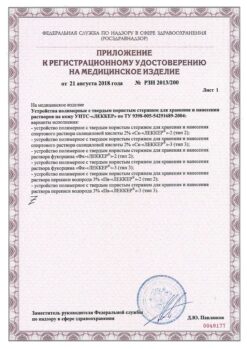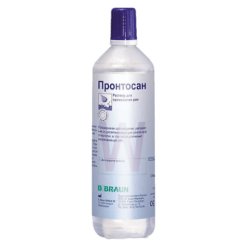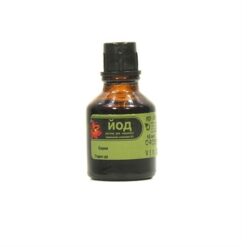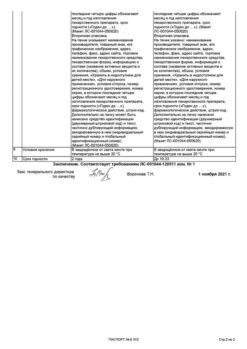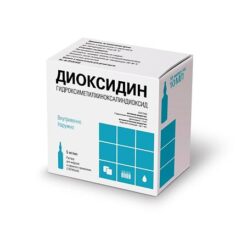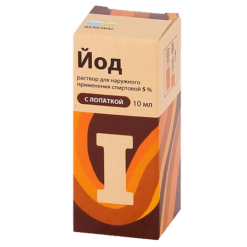No products in the cart.
Dixin, 10 mg/ml 10 pcs
€1.00
Out of stock
(E-mail when Stock is available)
Description
Pharmacotherapeutic group: antimicrobial agent – quinoxaline.
ATC code: not assigned.
Pharmacological properties
Pharmacodynamics
A broad spectrum antibacterial drug from the group of quinoxaline derivatives. It is active against Proteus vulgaris, Pseudomonas aeruginosa, Klebsiella pneumoniae, Escherichia coli, Shigella dysenteriae, Shigella flexneri, Shigella boydii, Shigella sonnei, Salmonella spp., Staphylococcus spp., Streptococcus spp., pathogenic anaerobes (Clostridium perfringens). Acts on strains of bacteria resistant to other antimicrobial drugs, including antibiotics.
The development of drug resistance of bacteria is possible. Treatment of burn and purulent-necrotic wounds, promotes faster clearing of the wound surface, stimulates reparative regeneration and marginal epithelization and favorably influences the course of the wound process.
The mechanism of bactericidal action of hydroxymethylquinoxalindioxide is damage of DNA biosynthesis of the microbial cell.
Pharmacokinetics
When applied topically, it is partially absorbed from the wound or burn surface and excreted by the kidneys.
Indications
Indications
Purulent bacterial infections caused by sensitive microflora when other chemotherapeutic agents are ineffective or poorly tolerated.
Intracavitary administration – purulent processes in the chest and abdominal cavity: purulent pleurisy, pleural empyema, peritonitis; cystitis, prevention of infectious complications after bladder catheterization; wounds with deep purulent cavities (soft tissue abscess, pelvic cellulitis, postoperative wounds of the urinary and biliary tract, purulent mastitis).
External use – wound and burn infections (superficial and deep wounds of various locations, soft tissue phlegmon, purulent wounds with osteomyelitis).
Pharmacological effect
Pharmacological effect
Pharmacotherapeutic group: antimicrobial agent – quinoxaline.
ATX code: not assigned.
Pharmacological properties
Pharmacodynamics
A broad-spectrum antibacterial drug from the group of quinoxaline derivatives. Active against Proteus vulgaris, Pseudomonas aeruginosa, Klebsiella pneumoniae, Escherichia coli, Shigella dysenteriae, Shigella flexneri, Shigella boydii, Shigella sonnei, Salmonella spp., Staphylococcus spp., Streptococcus spp., pathogenic anaerobes (Clostridium perfringens). Acts on strains of bacteria resistant to other antimicrobial drugs, including antibiotics.
The development of drug resistance in bacteria is possible. Treatment of burn and purulent-necrotic wounds promotes faster cleansing of the wound surface, stimulates reparative regeneration and marginal epithelization and has a beneficial effect on the course of the wound process.
The mechanism of the bactericidal action of hydroxymethylquinoxaline dioxide is to damage the DNA biosynthesis of the microbial cell.
Pharmacokinetics
When applied topically, it is partially absorbed from the wound or burn surface and excreted by the kidneys.
Special instructions
Special instructions
The drug is used under strict medical supervision in a hospital setting. Hydroxymethylquinoxaline dioxide is prescribed only to adults. Before starting the course of treatment, a drug tolerance test is carried out, for which 10 ml of a 1% solution is injected into the cavity. If there are no side effects within 3-6 hours (dizziness, chills, increased body temperature), a course of treatment begins. Otherwise, the drug is not prescribed.
Hydroxymethylquinoxaline dioxide is prescribed only for severe forms of infectious diseases or when other antibacterial drugs are ineffective, including cephalosporins of the II-IV generations, fluoroquinolones, carbapenems.
In case of chronic renal failure, the dose is reduced.
If pigmented spots appear, increase the duration of dose administration to 1.5-2 hours, reduce the dose, prescribe antihistamines or discontinue hydroxymethylquinoxaline dioxide.
To prevent adverse reactions, it is recommended to use it in combination with antihistamines and calcium supplements.
If adverse reactions occur, the dose should be reduced, antihistamines should be prescribed, and if necessary, the drug should be discontinued.
When used in elderly people, age-related decline in renal function should be taken into account, which may require a reduction in the dose of the drug.
If crystals fall out during storage, they are dissolved by heating the ampoules in a boiling water bath while shaking until the crystals are completely dissolved (clear solution). If, when cooled to 36-38°C, the crystals do not fall out again, the drug is suitable for use.
The drug cannot be used for intravenous administration due to the instability of the solution when stored at low temperatures.
Impact on the ability to drive vehicles and machinery
During the treatment period, care must be taken when driving vehicles and engaging in other potentially hazardous activities that require increased concentration and speed of psychomotor reactions.
Active ingredient
Active ingredient
Hydroxymethylquinoxaline dioxide
Composition
Composition
For 1 ml:
Pregnancy
Pregnancy
The use of the drug is contraindicated during pregnancy and breastfeeding.
Preclinical studies have shown that hydroxymethylquinoxaline dioxide has teratogenic and embryotoxic effects and has mutagenic properties. The use of the drug during lactation is possible only after transferring the child to artificial feeding.
Contraindications
Contraindications
Hypersensitivity to hydroxymethylquinoxaline dioxide, other drugs of the quinoxaline group, adrenal insufficiency (including a history), pregnancy, lactation, children (up to 18 years).
With caution
Kidney failure.
Side Effects
Side Effects
With intracavitary administration, headaches, chills, hyperthermia, dyspeptic disorders, muscle contractions, allergic reactions, photosensitizing effect (the appearance of pigmented spots on the body when exposed to sunlight) are possible.
When used externally – periwound dermatitis, itching.
Overdose
Overdose
In case of an overdose of the drug, acute adrenal insufficiency may develop, which requires immediate discontinuation of the drug and appropriate hormone replacement therapy.
Storage conditions
Storage conditions
In a place protected from light at a temperature of 15 to 25 ° C
Keep out of the reach of children.
Shelf life
Shelf life
2 years. Do not use after expiration date.
Manufacturer
Manufacturer
Ozon, Russia
Additional information
| Shelf life | 2 years. Do not use after the expiration date. |
|---|---|
| Conditions of storage | In the dark place at a temperature of 15 to 25 ° C Keep out of reach of children. |
| Manufacturer | Ozon, Russia |
| Medication form | solution |
| Brand | Ozon |
Related products
Buy Dixin, 10 mg/ml 10 pcs with delivery to USA, UK, Europe and over 120 other countries.


